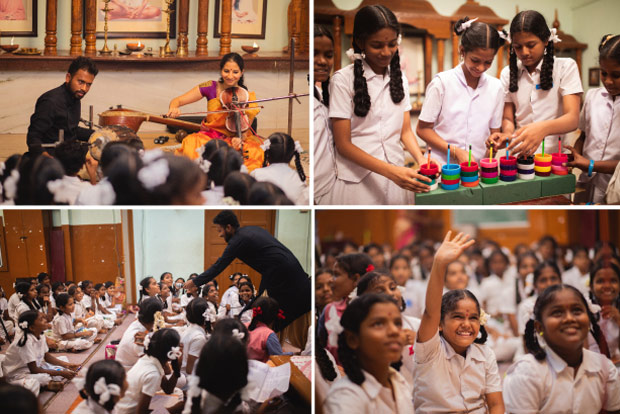Begin typing your search...
Musicians help students appreciate music through sounds
Through their music outreach programme at a city school, Shreya Devnath and Praveen Sparsh are working with students, many of whom hail from low-income families, and helping them understand all about music and rhythm.

Chennai
What is music? Is it the renditions heard at concert halls, or that which can be derived out of noises in public spaces? That was the question that Carnatic musicians Shreya Devnath and Praveen Sparsh set out to raise and answer among school students. Their music outreach programme called ‘Sound. Music. Carnatic music’ involved 100 girl students (6th to 9th graders) from a city school learning about music through unconventional means like sounds from the beach and using the abacus for music beats, popularly seen in math classes forcounting numbers.
Violinist Shreya, a student of the late renowned musician Lalgudi Jayaraman, says the programme is aimed at helping students truly appreciate music, and not just learn to sing. “Praveen and I created the module for students at the Sri Ramakrishna Math Vivekananda Centenary Girls Higher Secondary School in North Chennai as a passion project. We created the programme to go from sounds, to music, to Carnatic music. We wanted to raise questions on what music means. Usually, any music appreciation module would introduce students to ragam, thalam and other aspects of Carnatic music. But, we wanted students to ask questions on what music is,” Shreya tells DT Next.
With many of the school’s students hailing from low-income families, wherein a majority of parents are unemployed or work as daily-wage labourers, Shreya says the children receive very little support from their homes. “Our parents got us into music, and helped us attend music classes. We wanted to open up the dimension of music for these students,”she asserts.
As part of the module, the musicians introduced sounds from a public place, like a beach, to the students. “We recorded sounds of the wind, waves, horses and hawkers selling thenga, maanga, pattani sundal (peas popularly sold on the beaches). Using these sounds, we tried to create a song — helping the students understand that there’s a pitch to the wave, and a rhythm to the clatter. This tends to blur the lines between noise and sound,” elaborates Shreya. The programme also involved the use of xylophone to experience different sound notes and games using placards with seven notes of sa, ri, ga, ma, pa, da, ni. The musicians also played Carnatic music they would usually play at a sabha, so that the students were familiar with it.
What is music to one person can be noise to another and vice versa, she stresses. “Music is everywhere around us — it’s not just in classrooms or concert halls. No matter where we are, we are surrounded by music. We just have to tap into it and harmonise with it. We need to lose ourselves in that harmony,” the musician remarks. “We are very keen to work with more schools and take music to more children,” she adds.
Visit news.dtnext.in to explore our interactive epaper!
Download the DT Next app for more exciting features!
Click here for iOS
Click here for Android
Next Story



